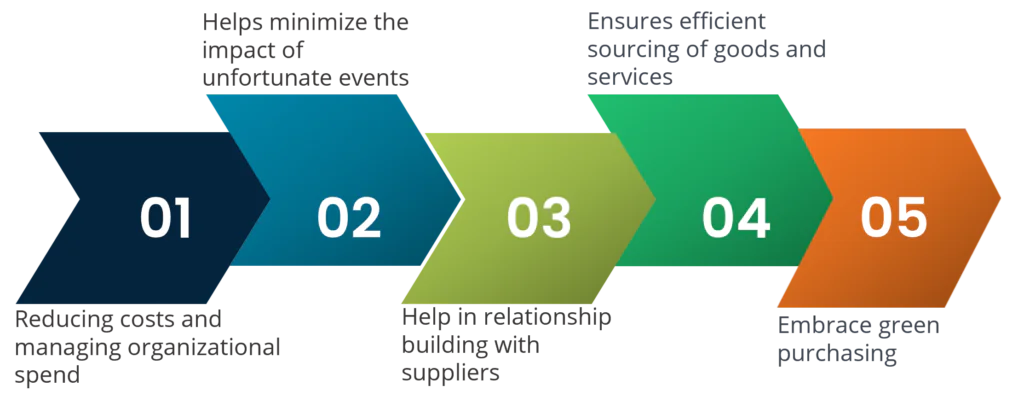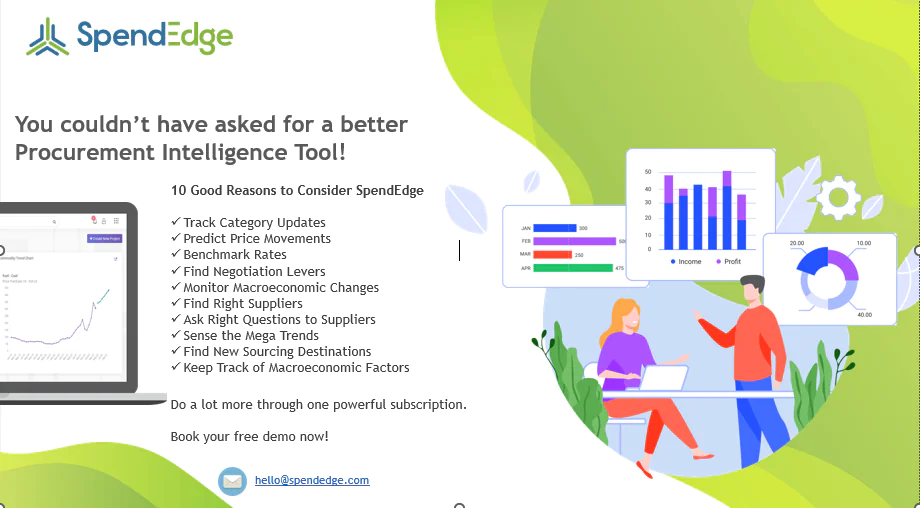Key takeaways
- Procurement is vital for businesses to obtain necessary goods and services efficiently, manage costs, and align purchases with organizational goals.
- There are four main types of procurement: direct, indirect, goods, and services procurement, each serving specific needs within a business.
- A pertinent procurement strategy aids in cost reduction, risk mitigation, relationship building with suppliers, efficient sourcing, and embracing sustainable practices.
- The procurement process involves stages such as sourcing, purchasing, and payment, each essential for ensuring smooth operations and effective resource management.
The process by which businesses locate and obtain the supplies and services they require to run is known as procurement. It includes every step of the process, including determining needs, finding suppliers, haggling over costs, and guaranteeing prompt delivery. However, purchasing goods isn’t the only thing to do; you also need to make sure you’re receiving the greatest deal, cultivate a solid rapport with suppliers, and match purchases with organizational goals.
Why Is Procurement Important in Business?
Procurement is a significant step in understanding supply chains. It helps a company find reliable suppliers who can provide goods and services that match the company’s needs at a competitive price. Whether a company is seeking raw materials for manufacturing, a marketing services provider, or new office supplies, the procurement process enables the business to choose the supplier that best meets all its requirements while avoiding wasting time, money, and valuable resources dealing with substandard suppliers. Reducing costs is an essential aspect of improving procurement processes. However, it is equally vital to identify suppliers that provide the quality of goods and services that the company needs and have a proven track record of delivering reliably.
What are the types of procurement or sourcing: Classification into 4 categories
Direct procurement
Direct procurement involves the acquisition of all necessary resources essential for the production of a final product. In the case of manufacturing companies, this encompasses the procurement of raw materials and components that are vital for the manufacturing process. Similarly, for retailers, direct procurement involves the purchase of items from wholesalers, which are subsequently resold to customers. This procurement process entails sourcing, selecting, and obtaining the required resources to fulfill the organization’s objectives and meet customer demands. By effectively managing direct procurement, companies can ensure a smooth supply chain and maintain the availability of essential materials for their production or resale operations.
Indirect procurement
Indirect procurement refers to the procurement of items that are necessary for the smooth functioning of day-to-day operations but do not directly impact on the company’s financial performance. This category includes a wide range of purchases, such as office supplies, furniture, advertising campaigns, consulting services, and equipment maintenance. While these items may not directly contribute to the company’s bottom line, they are crucial for maintaining a productive and efficient work environment. Indirect procurement involves sourcing and acquiring these non-production-related goods and services to support various departments and ensure the overall operational effectiveness of the organization.
Goods procurement:
Goods procurement primarily involves the acquisition of physical items, although it can also encompass non-physical items like software subscriptions. Successful goods procurement is heavily reliant on efficient supply chain management practices. This process encompasses both direct procurement, which involves obtaining materials and components necessary for production, and indirect procurement, which involves acquiring items essential for day-to-day operations. By effectively managing goods procurement, organizations can ensure the availability of necessary resources, optimize costs, and maintain a streamlined supply chain. This includes sourcing, selecting, and acquiring physical goods and non-physical items to support various aspects of the business and enhance overall operational efficiency.
Services procurement
Services procurement specifically focuses on the acquisition of people-based services within an organization. This encompasses various types of services, depending on the company’s requirements. Examples of services procurement include hiring individual contractors, engaging contingent labor, acquiring services from law firms, or obtaining on-site security services. It is important to note that services procurement can involve both direct and indirect procurement, as it encompasses the acquisition of services that directly contribute to the company’s operations, as well as those that support day-to-day activities. By effectively managing services procurement, organizations can ensure the availability of skilled professionals and necessary services to meet their business needs.
What is a pertinent procurement strategy?

Aid in reducing costs and managing organizational spend
Effective procurement on a tight budget involves strategic cost savings through a multifaceted approach. This intricate process includes negotiating with suppliers, optimizing internal administrative and operational expenses, and implementing automation. Decision-making at various hierarchical levels across company departments plays a pivotal role in this complex undertaking. A successful procurement strategy not only hinges on minimizing costs but also demands a comprehensive evaluation and adjustment of expenditures both externally and internally. Furthermore, fostering collaborative relationships with suppliers facilitates favorable terms and discounts. Rigorous supplier vetting and benchmarking ensure cost-effectiveness without compromising quality.
A relevant procurement strategy helps minimize the impact of unfortunate events
A well-crafted procurement strategy serves as a crucial risk mitigation tool, minimizing the impact of unforeseen events on an organization. By establishing robust supplier relationships, diversifying sources, and implementing contingency plans, businesses can enhance resilience. Proactive risk assessment and monitoring enable early identification of potential disruptions, allowing for swift and informed decision-making. Additionally, strategic procurement promotes cost-effective measures and efficient resource allocation, reducing vulnerabilities to market fluctuations or unexpected challenges. Ultimately, a comprehensive procurement strategy acts as a shield, enabling businesses to navigate uncertainties with agility and safeguarding against adverse consequences.
Help in relationship building with suppliers
A well-crafted procurement strategy serves as a crucial risk mitigation tool, minimizing the impact of unforeseen events on an organization. By establishing robust supplier relationships, diversifying sources, and implementing contingency plans, businesses can enhance resilience. Proactive risk assessment and monitoring enable early identification of potential disruptions, allowing for swift and informed decision-making. Additionally, strategic procurement promotes cost-effective measures and efficient resource allocation, reducing vulnerabilities to market fluctuations or unexpected challenges. Ultimately, a comprehensive procurement strategy acts as a shield, enabling businesses to navigate uncertainties with agility and safeguarding against adverse consequences.
Ensures efficient sourcing of goods and services
Efficient sourcing in a relevant procurement strategy involves optimizing the entire process of obtaining goods and services. It begins with rigorous market analysis to identify reliable suppliers, negotiate favorable terms, and ensure cost-effectiveness. Streamlined procurement workflows, clear specifications, and standardized procedures enhance efficiency. Leveraging technology for automation and real-time tracking accelerates sourcing cycles. Additionally, effective communication and collaboration with suppliers facilitate swift decision-making. By embracing efficiency, a procurement strategy minimizes delays, reduces costs, and maximizes the value derived from the sourcing process, ultimately contributing to organizational agility and competitiveness in the marketplace.
Embrace green purchasing
Embracing green purchasing in a relevant procurement strategy involves prioritizing environmentally sustainable practices. This entails selecting suppliers and products with eco-friendly credentials, emphasizing energy efficiency, and reducing the overall carbon footprint. Sustainable sourcing, waste reduction, and adherence to ethical environmental standards characterize this approach. By incorporating green criteria into procurement decisions, organizations not only contribute to environmental conservation but also align with evolving societal expectations. This strategy promotes corporate responsibility, enhances brand reputation, and positions the organization as a conscientious contributor to a more sustainable and ecologically balanced global supply chain.
Procurement stages
Sourcing stage
During the sourcing stage, a business identifies its needs, creates a purchase request, and assesses vendors. It’s important for the business to establish strong relationships with suppliers even after these initial steps are complete. This allows suppliers to learn from their partners, improve their products and processes, and develop trust.
Purchasing stage
Moving on to the purchasing stage, it involves negotiating terms, creating orders, and receiving and inspecting goods and services.
Payment stage
In the payment stage, the accounts payable team conducts three-way matching to ensure order and invoice accuracy. Once approved, the payment is arranged. It’s important to maintain and keep records of all invoices, orders, and payments.

Conclusion
Procurement plays a vital role in the success and sustainability of businesses across various industries, including the food and beverage sector. By effectively managing procurement processes, businesses can optimize costs, mitigate risks, build strong supplier relationships, and ensure the efficient sourcing of goods and services. Whether it’s direct procurement for raw materials or indirect procurement for office supplies, having a pertinent procurement strategy in place is essential for achieving organizational goals and maintaining competitiveness in the market. Embracing green purchasing practices further enhances corporate responsibility and contributes to a more sustainable future. From the sourcing stage to the payment stage, each step of the procurement process requires careful attention and strategic planning to drive value and foster growth.




